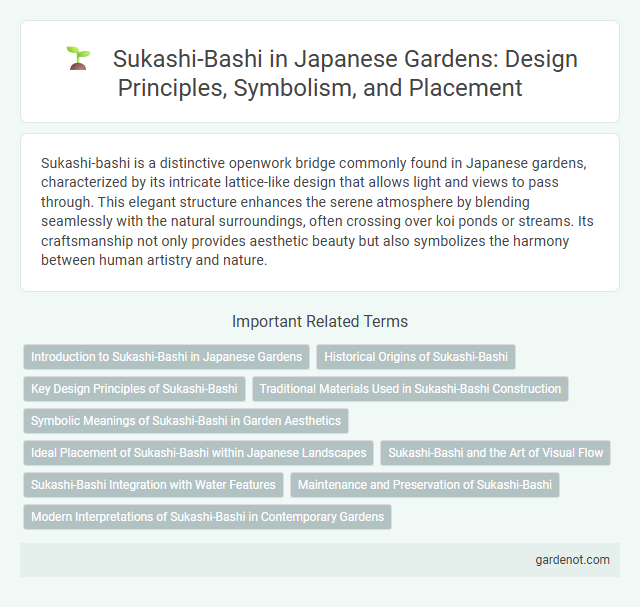Sukashi-bashi is a distinctive openwork bridge commonly found in Japanese gardens, characterized by its intricate lattice-like design that allows light and views to pass through. This elegant structure enhances the serene atmosphere by blending seamlessly with the natural surroundings, often crossing over koi ponds or streams. Its craftsmanship not only provides aesthetic beauty but also symbolizes the harmony between human artistry and nature.
Introduction to Sukashi-Bashi in Japanese Gardens
Sukashi-bashi is a traditional Japanese garden bridge characterized by its openwork design, allowing light and scenery to pass through the gaps between its wooden planks. This architectural feature integrates seamlessly with natural surroundings, enhancing the garden's aesthetic harmony and symbolizing the balance between solidity and emptiness. Often found spanning ponds or streams, Sukashi-bashi serves both functional and decorative purposes, embodying principles of Japanese garden design such as simplicity and connection with nature.
Historical Origins of Sukashi-Bashi
Sukashi-bashi bridges, characterized by their openwork or lattice design, trace their historical origins to Japan's Muromachi period (1336-1573), reflecting the Zen Buddhist influence on landscape architecture. These bridges were originally crafted to symbolize the concept of impermanence and the flow of life, often found in renowned gardens such as those at Ginkaku-ji in Kyoto. The intricate patterns not only enhance aesthetic appeal but also serve symbolic functions deeply rooted in Japanese cultural and spiritual traditions.
Key Design Principles of Sukashi-Bashi
Sukashi-bashi, a traditional Japanese garden bridge, emphasizes transparency and lightness by incorporating openwork patterns that allow viewers to glimpse the water and landscape beneath. The design principle prioritizes harmony with nature, using minimalistic aesthetics and natural materials like wood to blend seamlessly into surrounding scenery. Structural simplicity and intended partial visibility create a dynamic interaction between the bridge, water, and plants, enhancing the garden's overall tranquility and spatial depth.
Traditional Materials Used in Sukashi-Bashi Construction
Sukashi-bashi bridges in Japanese gardens feature traditional materials such as cedar and cypress wood, prized for their durability and natural beauty. The wooden planks are often hand-carved with intricate openwork patterns, allowing light and air to pass through, which enhances the bridge's aesthetic harmony with surrounding plants and water. Stone elements may be incorporated at the base, providing stability while maintaining the organic look integral to Japanese garden design.
Symbolic Meanings of Sukashi-Bashi in Garden Aesthetics
Sukashi-bashi, a perforated wooden bridge in Japanese gardens, symbolizes the delicate balance between nature and human craftsmanship, reflecting the aesthetic principle of wabi-sabi that values imperfection and transience. The open spaces in the bridge design allow light and water to pass through, representing transparency and the seamless flow of energy, or ki, within the garden environment. This bridge serves not only as a physical connector but also as a metaphorical passage between the mundane and the spiritual, enhancing the contemplative experience central to Japanese garden aesthetics.
Ideal Placement of Sukashi-Bashi within Japanese Landscapes
Sukashi-bashi bridges are ideally placed in Japanese gardens to create a harmonious balance between nature and architecture, often spanning small streams or ponds to provide a visual and functional focal point. Their perforated structure allows light and water to flow freely beneath, enhancing the garden's natural ambiance while encouraging contemplative pauses along meandering pathways. Strategic positioning near water features and among moss-covered stones accentuates the serene, meditative atmosphere characteristic of traditional Japanese landscape design.
Sukashi-Bashi and the Art of Visual Flow
Sukashi-bashi, a traditional Japanese garden bridge characterized by its openwork design, masterfully directs visual flow by framing garden views through its carefully spaced wooden or stone slats. This architectural element enhances spatial transparency, inviting observers to engage intimately with surrounding landscapes while guiding sightlines across ponds, stones, and foliage. The interplay of light and shadow on Sukashi-bashi surfaces further accentuates the dynamic rhythm and harmonious balance inherent in Japanese garden aesthetics.
Sukashi-Bashi Integration with Water Features
Sukashi-bashi, a traditional Japanese openwork wooden bridge, seamlessly integrates with water features by allowing light and air to pass through its lattice design, enhancing the reflective qualities of ponds beneath. This blending of structure and nature highlights the Zen philosophy of harmony, creating a tranquil visual connection between the bridge and the flowing or still waters. Its presence emphasizes spatial fluidity and encourages contemplation, enriching the garden's overall aesthetic and sensory experience.
Maintenance and Preservation of Sukashi-Bashi
Sukashi-bashi, a traditional Japanese garden bridge known for its intricate openwork design, requires meticulous maintenance to preserve its structural integrity and aesthetic appeal. Regular cleaning to remove moss and debris, along with periodic inspections for wood decay or weathering, ensures longevity. Preservation efforts often involve using traditional materials and techniques to maintain authenticity and harmony within the garden environment.
Modern Interpretations of Sukashi-Bashi in Contemporary Gardens
Modern interpretations of Sukashi-bashi emphasize openwork designs that blend traditional aesthetics with contemporary materials such as steel and glass. These bridges incorporate minimalist lines and abstract patterns, enhancing light play and creating dynamic shadows in garden spaces. Contemporary gardens use Sukashi-bashi to harmonize natural elements with urban landscapes, promoting tranquility and artistic expression.
Sukashi-bashi Infographic

 gardenot.com
gardenot.com